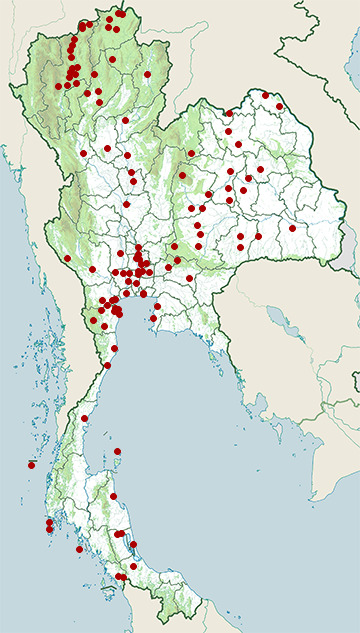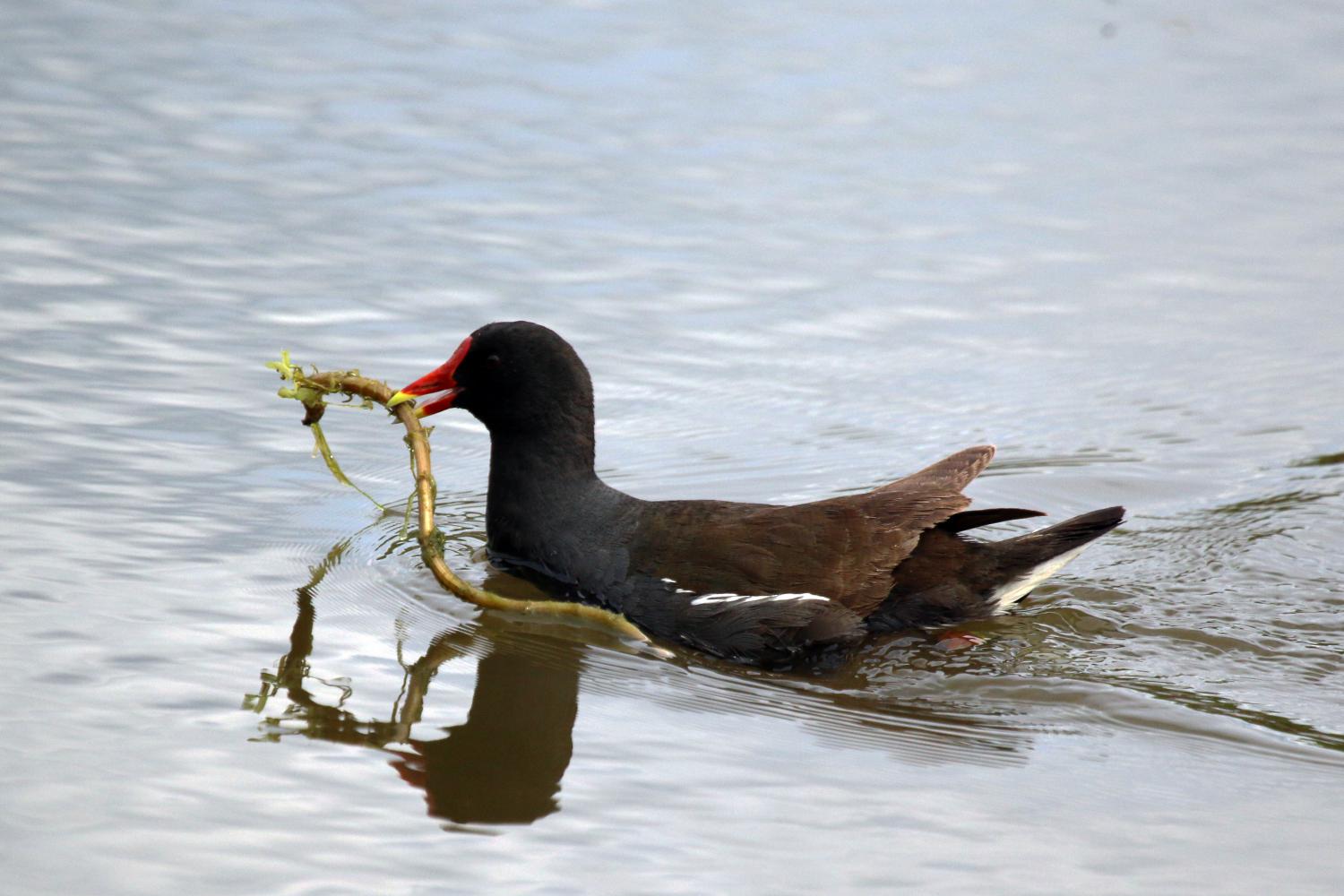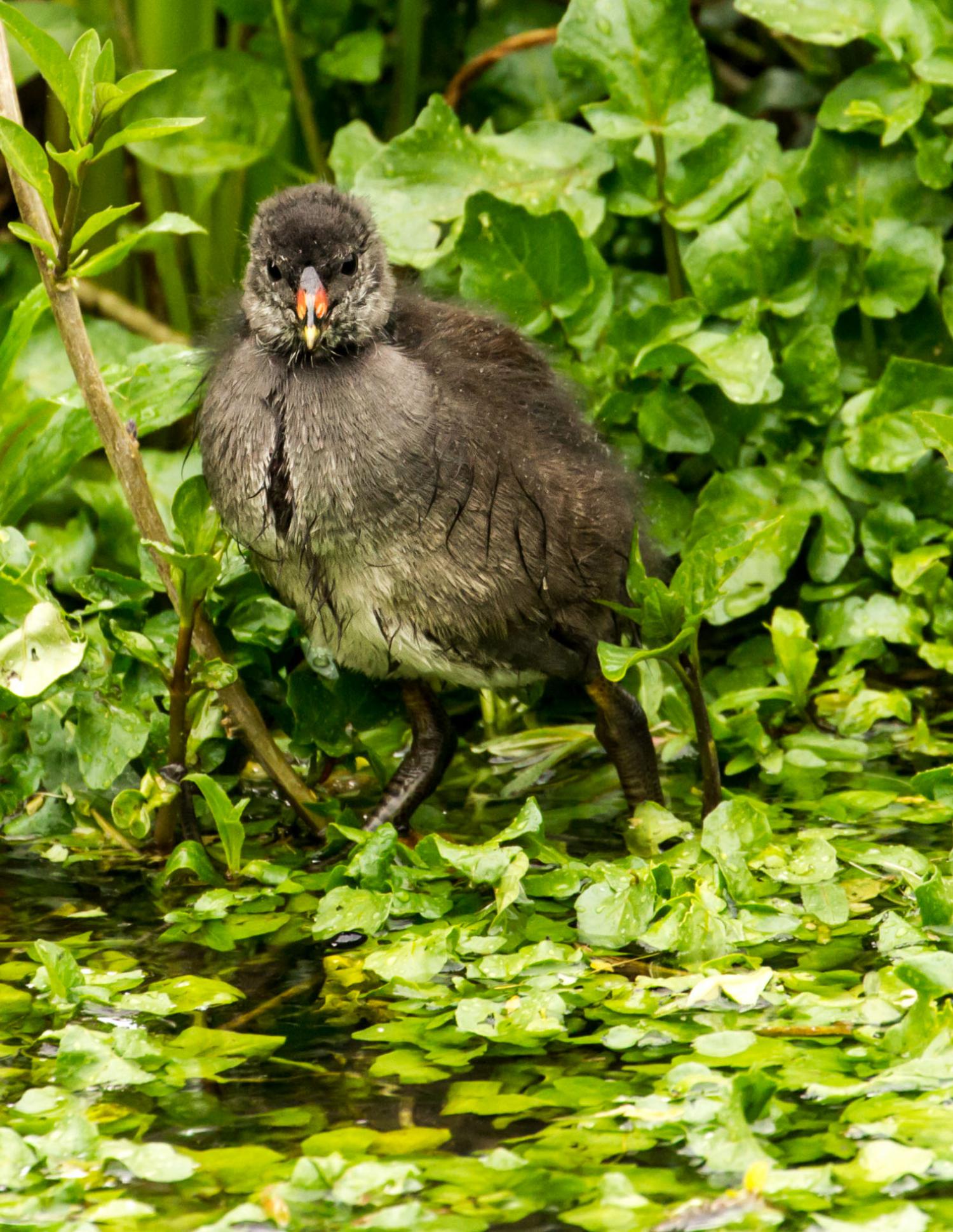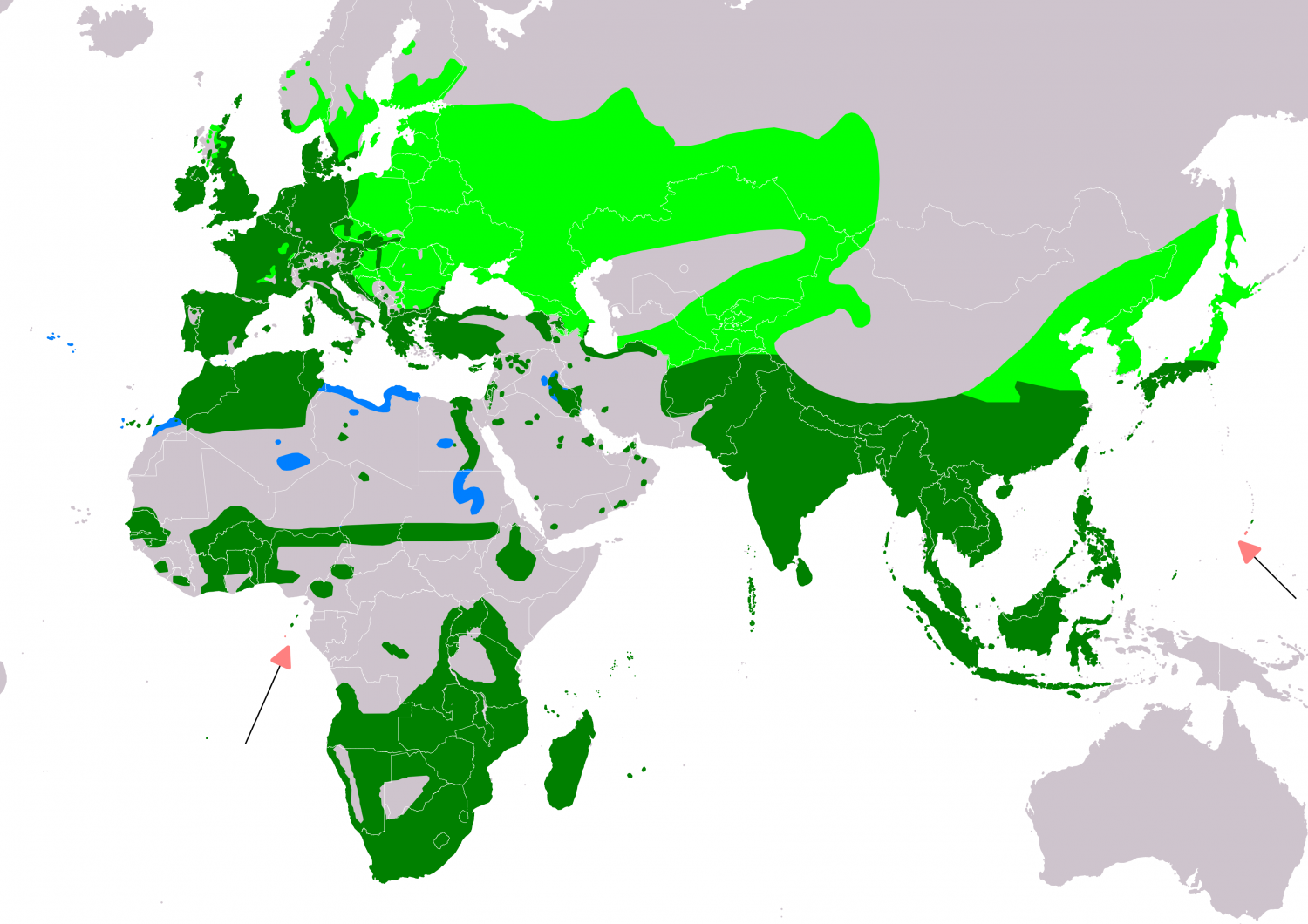Species of Thailand
Common moorhen
Gallinula chloropus
Carolus Linnaeus, 1758
In Thai: นกอีล้ำ
The common moorhen (Gallinula chloropus), also known as the waterhen or swamp chicken, is a bird species in the rail family (Rallidae). It is distributed across many parts of the Old World.
The common moorhen lives around well-vegetated marshes, ponds, canals and other wetlands. The species is not found in the polar regions or many tropical rainforests. Elsewhere it is likely the most common rail species, except for the Eurasian coot in some regions.
The closely related common gallinule of the New World has been recognized as a separate species by most authorities, starting with the American Ornithologists' Union and the International Ornithological Committee in 2011.
Name
The name mor-hen has been recorded in English since the 13th century. The word moor here is an old sense meaning marsh; the species is not usually found in moorland. An older name, common waterhen, is more descriptive of the bird's habitat.
A "watercock" is not a male "waterhen" but the rail species Gallicrex cinerea, not closely related to the common moorhen. "Water rail" usually refers to Rallus aquaticus, again not closely related.
The scientific name Gallinula chloropus comes from the Latin Gallinula (a small hen or chicken) and the Greek chloropus (khloros green or yellow, pous foot).
Description
The moorhen is a distinctive species, with dark plumage apart from the white undertail, yellow legs and a red frontal shield. The young are browner and lack the red shield. The frontal shield of the adult has a rounded top and fairly parallel sides; the tailward margin of the red unfeathered area is a smooth waving line. In the related common gallinule of the Americas, the frontal shield has a fairly straight top and is less wide towards the bill, giving a marked indentation to the back margin of the red area.
The common moorhen gives a wide range of gargling calls and will emit loud hisses when threatened. A midsized to large rail, it can range from 30 to 38 cm in length and span 50 to 62 cm across the wings. The body mass of this species can range from 192 to 500 g.
Habitat
This is a common breeding bird in marsh environments, well-vegetated lakes and even in city parks. Populations in areas where the waters freeze, such as eastern Europe, will migrate to more temperate climates. In China, common moorhen populations are largely resident south of the Yangtze River, whilst northern populations migrate in the winter, therefore these populations show high genetic diversity.
Diet and feeding
This species will consume a wide variety of vegetable material and small aquatic creatures. They forage beside or in the water, sometimes walking on lilypads or upending in the water to feed. They are often secretive, but can become tame in some areas. Despite loss of habitat in parts of its range, the common moorhen remains plentiful and widespread.
Breeding
The birds are territorial during breeding season. The nest is a basket built on the ground in dense vegetation. Laying starts in spring, between mid-March and mid-May in Northern hemisphere temperate regions. About 8 eggs are usually laid per female early in the season; a brood later in the year usually has only 5–8 or fewer eggs. Nests may be re-used by different females. Incubation lasts about three weeks. Both parents incubate and feed the young. These fledge after 40–50 days, become independent usually a few weeks thereafter, and may raise their first brood the next spring. When threatened, the young may cling to the parents' body, after which the adult birds fly away to safety, carrying their offspring with them.
Status and population
On a global scale – all subspecies taken together – the common moorhen is as abundant as its vernacular name implies. It is therefore considered a species of Least Concern by the IUCN. However, small populations may be prone to extinction. The population of Palau, belonging to the widespread subspecies G. c. orientalis and locally known as debar (a generic term also used for ducks and meaning roughly "waterfowl"), is very rare, and apparently the birds are hunted by locals. Most of the population on the archipelago occurs on Angaur and Peleliu, while the species is probably already gone from Koror. In the Lake Ngardok wetlands of Babeldaob, a few dozen still occur, but the total number of common moorhens on Palau is about in the same region as the Guam population: fewer than 100 adult birds (usually fewer than 50) have been encountered in any survey.
The common moorhen is one of the birds (the other is the Eurasian coot, Fulica atra) from which the cyclocoelid flatworm parasite Cyclocoelum mutabile was first described. The bird is also parasitised by the moorhen flea, Dasypsyllus gallinulae.
Subspecies
Five subspecies are today considered valid; several more have been described that are now considered junior synonyms. Most are not very readily recognizable, as differences are rather subtle and often clinal. Usually, the location of a sighting is the most reliable indication as to subspecies identification, but the migratory tendencies of this species make identifications based on location not completely reliable. In addition to the extant subspecies listed below, an undescribed form from the Early Pleistocene is recorded from Dursunlu in Turkey.
| List of subspecies by date of description | |||
|---|---|---|---|
| Common and, trinomial names | Description | Range | |
| Eurasian common moorhen, G. c. chloropus (Linnaeus, 1758), Includes correiana and indica. | Wings and back blackish-olive | Ranges from Northwest Europe to North Africa and eastwards to Central Siberia and from the humid regions of the Indian Subcontinent and Southeast Asia eastwards to Japan; also found the Canary, Azores, Madeira, and Cape Verde islands. | |
| Indo-Pacific common moorhen, G. c. orientalis (Horsfield, 1821) | Small, with slate grey upperwing coverts and large frontal shield. | Found in the Seychelles, Andaman Islands, and South Malaysia through Indonesia; also found in the Philippines and Palau. The breeding population existing on Yap in Micronesia since the 1980s is probably of this subspecies, but might be of the rare G. c. guami., Population size: Perhaps a few 100s on Palau as of the early 2000s, less than 100 on Yap as of the early 2000s. | |
| African common moorhen, G. c. meridionalis (C. L. Brehm, 1831) | Similar to orientalis, but the frontal shield is smaller. | Found in Sub-Saharan Africa and Saint Helena. | |
| Madagascan common moorhen, G. c. pyrrhorrhoa (A. Newton, 1861) | Similar to meridionalis, but the undertail coverts are buff. | Found on the islands of Madagascar, Réunion, Mauritius, and the Comoros. | |
| Mariana common moorhen, G. c. guami (Hartert, 1917), Called pulattat in Chamorro. | Body plumage is very dark. | Endemic to the Northern Mariana Islands, but see also G. c. orientalis above., Population size: About 300 as of 2001. |
This article uses material from Wikipedia released under the Creative Commons Attribution-Share-Alike Licence 3.0. Eventual photos shown in this page may or may not be from Wikipedia, please see the license details for photos in photo by-lines.
Category / Seasonal Status
BCST Category: Recorded in an apparently wild state within the last 50 years
BCST Seasonal statuses:
- Resident or presumed resident
- Non-breeding visitor
Scientific classification
- Kingdom
- Animalia
- Phylum
- Chordata
- Class
- Aves
- Order
- Gruiformes
- Family
- Rallidae
- Genus
- Gallinula
- Species
- Gallinula chloropus
Common names
- Thai: นกอีล้ำ
Subspecies
Gallinula chloropus chloropus, Carolus Linnaeus, 1758
Common name: Eurasian common moorhen
Range: Includes correiana and indica. Wings and back blackish-olive. Ranges from Northwest Europe to North Africa and eastwards to Central Siberia and from the humid regions of the Indian Subcontinent and Southeast Asia eastwards to Japan; also found the Canary, Azores, Madeira, and Cape Verde islands.
Gallinula chloropus guami, Ernst Johann Otto Hartert, 1917
Common name: Mariana common moorhen
Range: Called pulattat in Chamorro. Body plumage is very dark. Endemic to the Northern Mariana Islands, but see also G. c. orientalis above., Population size: About 300 as of 2001.
Gallinula chloropus meridionalis, Christian Ludwig Brehm, 1831
Common name: African common moorhen
Range: Similar to orientalis, but the frontal shield is smaller. Found in Sub-Saharan Africa and Saint Helena.
Gallinula chloropus orientalis, Thomas Horsfield, 1821
Common name: Indo-Pacific common moorhen
Range: Small, with slate grey upperwing coverts and large frontal shield. Found in the Seychelles, Andaman Islands, and South Malaysia through Indonesia; also found in the Philippines and Palau. The breeding population existing on Yap in Micronesia since the 1980s is probably of this subspecies, but might be of the rare G. c. guami., Population size: Perhaps a few 100s on Palau as of the early 2000s, less than 100 on Yap as of the early 2000s.
Gallinula chloropus pyrrhorrhoa, Alfred Newton, 1861
Common name: Madagascan common moorhen
Range: Similar to meridionalis, but the undertail coverts are buff. Found on the islands of Madagascar, Réunion, Mauritius, and the Comoros.
Synonyms
- Fulica chloropus, Carolus Linnaeus (1758)
Conservation status

Least Concern (IUCN3.1)
Photos
Please help us review the bird photos if wrong ones are used. We can be reached via our contact us page.
Range Map

- Amphawa District, Samut Songkhram
- Ban Laem District, Phetchaburi
- Ban Lueam District, Nakhon Ratchasima
- Ban Phai District, Khon Kaen
- Ban Phraek District, Phra Nakhon Si Ayutthaya
- Bang Ban District, Phra Nakhon Si Ayutthaya
- Bang Lamung District, Chonburi
- Bang Len District, Nakhon Pathom
- Bang Pa In District, Phra Nakhon Si Ayutthaya
- Bang Pahan District, Phra Nakhon Si Ayutthaya
- Bang Phra Non-Hunting Area
- Bang Pu Recreation Centre
- Bangkok Province
- Borabue District, Maha Sarakham
- Bueng Boraped Non-Hunting Area
- Bueng Khong Long Non-Hunting Area
- Chatturat District, Chaiyaphum
- Chiang Dao District, Chiang Mai
- Chiang Dao Wildlife Sanctuary
- Chiang Saen District, Chiang Rai
- Doi Inthanon National Park
- Doi Lo District, Chiang Mai
- Doi Pha Hom Pok National Park
- Doi Suthep - Pui National Park
- Fang District, Chiang Mai
- Hang Chat District, Lampang
- Hat Yai District, Songkhla
- Huai Chorakhe Mak Reservoir Non-Hunting Area
- Kabin Buri District, Prachinburi
- Kaeng Krachan National Park
- Kamphaeng Saen District, Nakhon Pathom
- Kantharawichai District, Maha Sarakham
- Khao Sam Roi Yot National Park
- Khao Yai National Park
- Khao Yoi District, Phetchaburi
- Khlong Luang District, Pathum Thani
- Khuan Khanun District, Phatthalung
- Ko Lanta National Park
- Kumphawapi District, Udon Thani
- Kut Thing Non-Hunting Area
- Laem Pak Bia
- Mae Ai District, Chiang Mai
- Mae Chan District, Chiang Rai
- Mae Rim District, Chiang Mai
- Mae Taeng District, Chiang Mai
- Mae Tha, Lampang District, Lampang
- Mueang Chiang Mai District, Chiang Mai
- Mueang Chiang Rai District, Chiang Rai
- Mueang Kalasin District, Kalasin
- Mueang Kanchanaburi District, Kanchanaburi
- Mueang Khon Kaen District, Khon Kaen
- Mueang Lampang District, Lampang
- Mueang Lamphun District, Lamphun
- Mueang Nakhon Ratchasima District, Nakhon Ratchasima
- Mueang Nan District, Nan
- Mueang Nong Khai District, Nong Khai
- Mueang Pan District, Lampang
- Mueang Pathum Thani District, Pathum Thani
- Mueang Phayao District, Phayao
- Mueang Phetchaburi District, Phetchaburi
- Mueang Phichit District, Phichit
- Mueang Phitsanulok District, Phitsanulok
- Mueang Phuket District, Phuket
- Mueang Prachuap Khiri Khan District, Prachuap Khiri Khan
- Mueang Samut Sakhon District, Samut Sakhon
- Mueang Samut Songkhram District, Samut Songkhram
- Mueang Sisaket District, Sisaket
- Mueang Sukhothai District, Sukhothai
- Mueang Suphanburi District, Suphan Buri
- Mueang Surin District, Surin
- Mueang Tak District, Tak
- Mueang Udon Thani District, Udon Thani
- Mueang Uttaradit District, Uttaradit
- Non Thai District, Nakhon Ratchasima
- Nong Bong Khai Non-Hunting Area
- Nong Plak Phra Ya – Khao Raya Bangsa Non-Hunting
- Nong Song Hong District, Khon Kaen
- Nong Waeng Non-Hunting Area
- Nong Ya Plong District, Phetchaburi
- Nong Yai Area Development Project Under Royal Init
- Op Khan National Park
- Pak Chong District, Nakhon Ratchasima
- Pak Phli District, Nakhon Nayok
- Pak Thale
- Pak Tho District, Ratchaburi
- Pak Thong Chai District, Nakhon Ratchasima
- Pha Daeng National Park
- Phra Nakhon Si Ayutthaya District, Phra Nakhon Si Ayutthaya
- Phu Khiao Wildlife Sanctuary
- Phu Kradueng District, Loei
- Phutthamonthon District, Nakhon Pathom
- Sai Noi District, Nonthaburi
- Sai Yok National Park
- Samut Prakan Province
- San Sai District, Chiang Mai
- Sanam Bin Reservoir Non-Hunting Area
- Sathing Phra District, Songkhla
- Surin Islands
- Taphan Hin District, Phichit
- Tha Sala District, Nakhon Si Thammarat
- Tha Yang District, Phetchaburi
- Thalang District, Phuket
- Thale Ban National Park
- Thale Noi Non-Hunting Area
- Than Sadet - Koh Pha-Ngan National Park
- Thanyaburi District, Pathum Thani
- Wang Noi District, Phra Nakhon Si Ayutthaya
- Wat Phai Lom & Wat Ampu Wararam Non-Hunting Area
- Wiang Chai District, Chiang Rai




